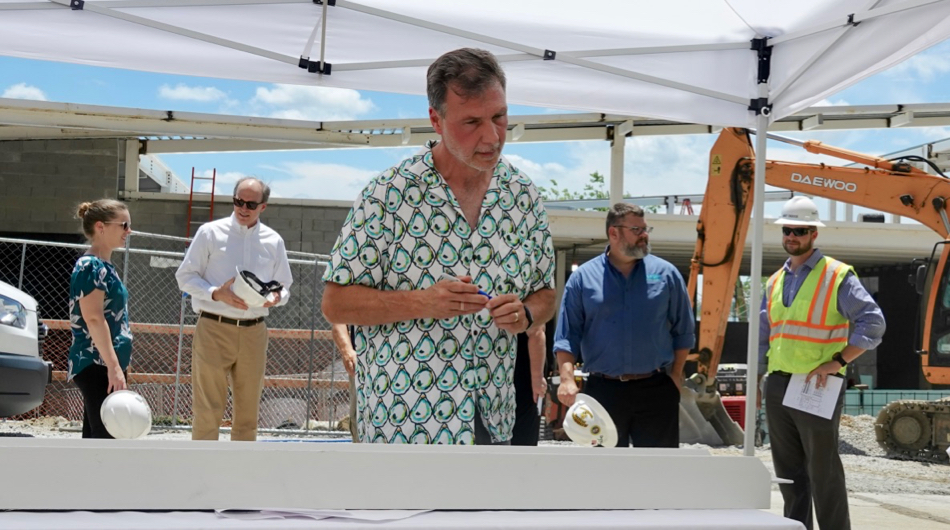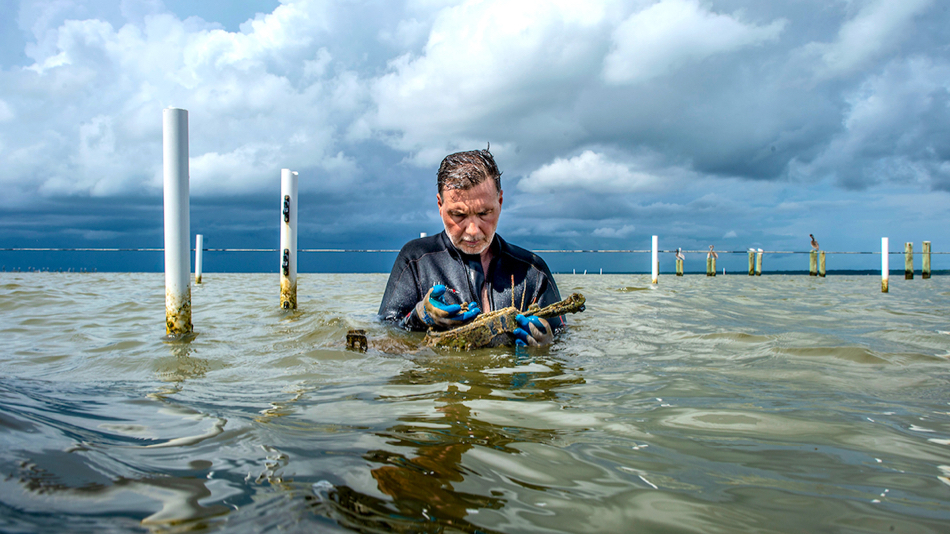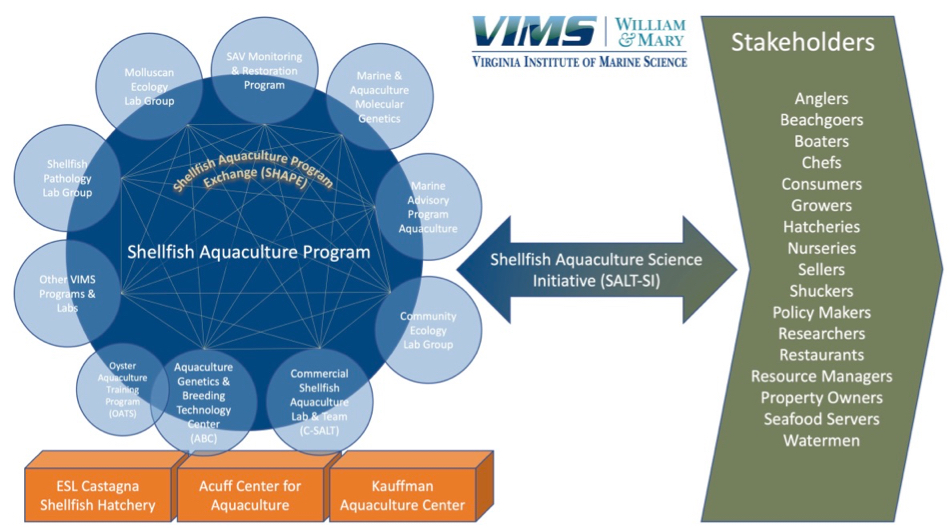VIMS welcomes coordinator of new Shellfish Aquaculture Program
Editor’s note: We’re delighted to accompany our full slate of “Oystober” programming with a pair of articles that each explore an exciting advance in shellfish aquaculture at VIMS. The first introduces Dr. Bill Walton, recently hired as Acuff Professor of Marine Science and coordinator of our new Shellfish Aquaculture Program. The second will highlight and celebrate the upcoming opening of our Acuff Center for Aquaculture, the new home for VIMS’ Shellfish Research Hatchery and nexus for the people and programs working to bring sustainable shellfish farming to the next level in the Commonwealth and nation.
Dr. Bill Walton, Acuff professor of marine science, seeks to foster thriving, sustainable industry
William & Mary’s Virginia Institute of Marine Science has welcomed Dr. Bill Walton as Acuff Professor and coordinator of VIMS’ newly organized Shellfish Aquaculture Program.
“Bill brings a wealth of experience and accomplishments to our campus,” says VIMS Dean & Director Derek Aday. “His knowledge and enthusiasm bode well for the continued success and growth of shellfish aquaculture in Virginia, the Chesapeake Bay, and nationwide.”
Walton previously headed the Auburn University Shellfish Lab, located on Dauphin Island along Alabama’s Gulf Coast, with joint appointments at the Dauphin Island Sea Lab and with the Mississippi-Alabama Sea Grant Consortium. Prior to that, he was a researcher at the Woods Hole Oceanographic Institution in Massachusetts and a fisheries and aquaculture specialist with the Cape Cod Cooperative Extension & Woods Hole Sea Grant. He has even served as a shellfish constable—in Cape Cod’s historic oyster village of Wellfleet.
A winning combination
When asked about the main factors that attracted him to VIMS, Walton said, “The creation of a new position was an exciting opportunity to join a world-class institution to bring the best science to bear on the challenges and opportunities facing shellfish aquaculture. VIMS has great people and facilities and Virginia has an amazing shellfish aquaculture industry—that combination was hard to resist.”
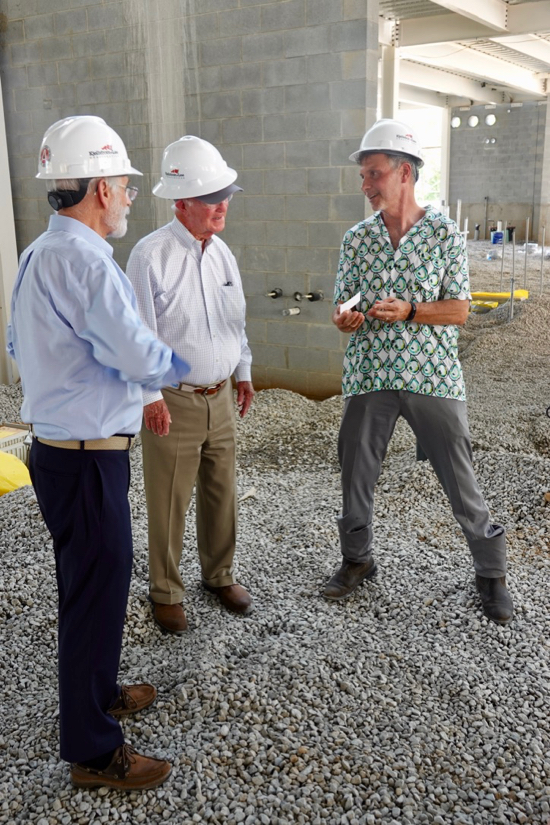 The Shellfish Aquaculture Program is designed to integrate VIMS’ many related efforts in research, teaching, and advisory service, and to guide work within VIMS’ aquaculture facilities—the soon-to-open Acuff Center for Aquaculture on VIMS’ main Gloucester Point campus, the newly renovated Castagna Shellfish Hatchery at VIMS’ Eastern Shore Laboratory, and the Kauffman Center for Aquaculture on the Rappahannock River. Facilitating this integration is an internal VIMS listserve, the Shellfish Aquaculture Program Exchange or SHAPE, and a bi-weekly journal discussion group.
The Shellfish Aquaculture Program is designed to integrate VIMS’ many related efforts in research, teaching, and advisory service, and to guide work within VIMS’ aquaculture facilities—the soon-to-open Acuff Center for Aquaculture on VIMS’ main Gloucester Point campus, the newly renovated Castagna Shellfish Hatchery at VIMS’ Eastern Shore Laboratory, and the Kauffman Center for Aquaculture on the Rappahannock River. Facilitating this integration is an internal VIMS listserve, the Shellfish Aquaculture Program Exchange or SHAPE, and a bi-weekly journal discussion group.
As program coordinator, Walton says his overall goal is to “work with VIMS scientists to conduct state-of-the-art research on all issues related to shellfish aquaculture, in order to advance and support a thriving and sustainable shellfish aquaculture community in Virginia and around the U.S. He says the group’s work “will be driven by the needs of stakeholders, where we work to solve problems, provide solutions, and train the next generation of shellfish growers and scientists – all guided by the best available science.” He also plans to develop a graduate-level aquaculture curriculum to augment VIMS’ existing Oyster Aquaculture Training program.
Walton stresses a balanced approach encompassing all locally important commercial shellfish species, including hard clams, oysters, and bay scallops, with the potential addition of soft-shell clams and other species. Thanks largely to advances pioneered at VIMS, Virginia currently leads the U.S. in hard clam production, and is number one on the East Coast for production of the Eastern oyster.
Walton says his ultimate aim as program coordinator is to ensure that “when the shellfish aquaculture industry and regulatory agencies have challenges or opportunities, they‘ll look to VIMS not only as a resource for information but also as a partner in solving problems and providing practical tools and advice guided by the best available science.” 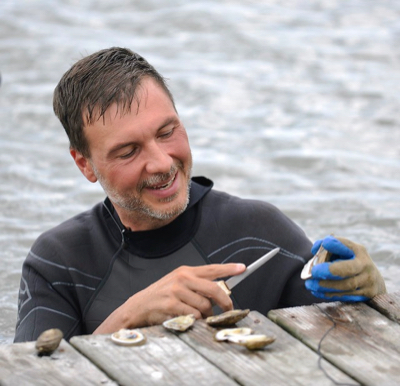 “My hope,” he adds, “is that you’ll see even more VIMS researchers out on shellfish farms, getting wet and muddy, side by side with the shellfish growers, listening to their concerns and identifying research that can have the most impact.”
“My hope,” he adds, “is that you’ll see even more VIMS researchers out on shellfish farms, getting wet and muddy, side by side with the shellfish growers, listening to their concerns and identifying research that can have the most impact.”
Noun and verb
One of Walton’s first steps as coordinator of the Shellfish Aquaculture Program was to establish a Shellfish Aquaculture Science Initiative, or SALT-SI. To explain the difference between the two entities, he says “If our Program is the noun—a group of people—our Initiative is the verb, it's what we're trying to do.” “I want the two separated conceptually,” he adds, “because we may get to a point where our Program collaborates with others to accomplish the goals of SALT-SI. The idea of the Initiative as an active effort allows us to be very inclusive as we go forward. We can have partners not only internally, but could potentially include external stakeholders as well.”
C-SALT
To identify his own component of VIMS’ Shellfish Aquaculture Program, Walton and his graduate students came up with another descriptively briny epithet: the Commercial Shellfish Aquaculture Lab and Team, or C-SALT.
“My lab’s research,” says Walton, “will focus on problems and opportunities from the shellfish aquaculture industry to improve their production, either in terms of more shellfish or more income, to promote sustainable shellfish aquaculture that provides jobs in our rural coastal communities while also helping the environment. While we’ll do the work at a high academic level, my personal goal will be to deliver results that shellfish growers and regulators use and put into practice.”
Comprising Walton’s C-SALT are PhD student David Arancibia and master’s students Julia Grenn and Matt LaGanke. Arancibia is comparing yield, quality, and consumer response to the two common methods of growing oysters in Virginia: bottom cages and surface baskets. Grenn plans to examine how the methods used to control biofouling might impact the growing conditions within an oyster basket. LaGanke will evaluate the feasibility of using radio frequency tags to track inventory in a commercial shellfish operation.
As clearly shown by VIMS’ annual crop reporting surveys, shellfish aquaculture in Virginia has experienced healthy growth during the last decade and more. Walton would like to see that trend continue.
“There are so few activities that promise benefits for the environment, the economy, and our culture the way that shellfish aquaculture does when practiced responsibly and sustainably,” he says. “Shellfish, whether wild or raised by growers, help improve water quality and may create habitat for all sorts of marine life. In terms of the economy, shellfish farming is an incredibly valuable industry that supports and creates jobs in our rural coastal communities. And culturally, it’s is a modern twist on an historical industry—one that still allows young women and men to continue their families’ traditions of living along and working in our coastal waters.”
“It’s hard to know what the exact nature and scope of shellfish aquaculture will be in 5 or 10 years,” says Walton, “but I hope that the value of Virginia’s industry will grow through both increased production and the addition of higher value products, while remaining an environmentally responsible industry. We see opportunities for young people to work and have careers in this industry in a way that helps support our rural coastal communities, and serves as a model nationally for sustainable, responsible shellfish aquaculture. I’m really excited by where we are now and where we might go.”

